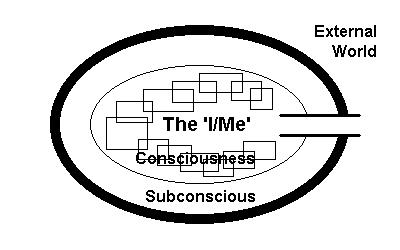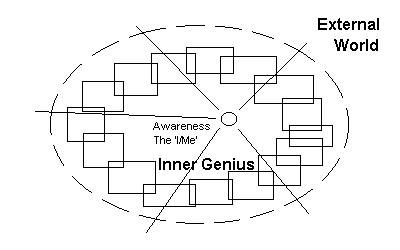A lot of the time (if not all of the time) in life you can find that personal beliefs, expectations and assumptions colour perceptions. Sometimes these beliefs, expectations and assumptions also become self-fulfilling prophecies, such as the interviewee whose confidence in their ability allows them to relax and give a good interview – which gets them the job.
If these things are of importance in day-to-day living, then they are especially important when dealing with ‘The Mind’ and what it is capable of achieving.
Your concept, understanding or ‘model’ of how the mind functions can be the key to unlocking its potential. Maxwell Maltz, originator of Psycho-Cybernetics, likened the mind to a determined and adaptive ‘goal-seeking mechanism’ – in that it constantly attempts to actualise whatever is presented to it.
Now, if someone chooses to maintain and reinforce the belief that ‘the subconscious’ is no more than some lackey only useful for tying shoelaces and riding bicycles then this person will find that their mind can easily attain this goal and may continue to sit ‘idling’ for evermore. On the other hand what if you instead refer to your mind as the ‘Inner Genius’ and cultivate an expectation that your mind can constantly surprise you with increasing inspiration, creativity and insight? Then you are immediately heading in a direction that’s much more focussed on exploring what may or may not be possible in this world.
So let’s take a look at some of the characteristics of the current popular, but constrictive, model of the mind and then examine an approach better suiting our purposes.
We can imagine this ‘model’ as looking like this:

You can see that ‘Consciousness’, the sense of self, is quite large. Inside ‘Consciousness’ there are a number of interlocking boxes which represent various skills, behaviours and mental resources. These boxes are located inside Consciousness for two reasons. Firstly ‘Conscious Awareness’ is perceived as being big, powerful and ‘in control’. It is the Master of the Mind and all of the ‘little box’ resources are seen as direct extensions of this control. Secondly the sense of self, of being ‘Me’, identifies strongly with the results of these boxes. It defines its identity using these things. It says ‘I am ...’ and adds a skill or behaviour.
In Western societies this sense of ‘Me’ is often ‘stuck’ in near-total identification with areas of the mind that are predominantly linear / logical / literal and step-by-step.
In stark contrast to all of this activity the ‘Subconscious’ just sits around the outside and doesn’t seem to be doing much of any real importance.
Around the mind there is a thick barrier: the external world is clearly and cleanly separated from the mind, which remains inviolate and unaffected by outside interference.
The only exception to this barrier is a channel running from the outside world straight into conscious awareness. This direct link enables Consciousness to perceive the essential objective reality of the external world.
This type of model, although ‘successful’ in the sense that the human race is managing to survive whilst using it, does have some unfortunate and unnecessary drawbacks.
You might think that seeing Consciousness as being the ‘master of the mind’ might be a good idea. After all if the mind is a goal-seeking mechanism then shouldn’t it make it happen? Well, in theory maybe but in practice it just doesn’t seem to work.
It’s been said many times that the so-called ‘conscious mind’ can concentrate on only a handful of things at a time and gets ‘overloaded’ easily. Is there something inherent in the nature of consciousness that has a small scope of focus? Or is it just a case of our awareness currently being ‘stuck’ in parts of the mind that just happen to have a narrow scope of awareness? Whatever the actual reason, the end result is that ‘consciousness,’ as we currently experience it, is simply not up to the task of micro-managing every detail of life.
In this model Conscious direction of will power is seen as the ultimate force of inner change, yet experience can show clearly that many patterns of behaviour or feeling cannot be changed at all by this method. Other habits can be changed only with painful slowness and enormous effort even if they are clearly dysfunctional and/or dangerous. In other cases, such as phobias, conscious will power is simply brushed aside. Attempts to rationalise this failure may end up with the conclusion that these habits cannot be changed at all, or the person may collapse into frustration and depression.
The old model, with its over-identification of the ‘self’ with behavioural patterns, may also reduce the possibilities for useful self-change. If the ‘little boxes’ are seen as being a core part of the essential self then how can they be changed? “That’s just the sort of person I am,” is the response. Any suggestion that they could be changed raises fears of somehow 'losing your identity'. This model offers very little scope for self-development beyond the training of physical skills or the intellectual ‘understanding’ and recall of facts, figures and theorems.
This model also fails to cope with varying world-views and understandings. Again and again perception and understanding have been shown to be fallible, being subjective and open to misinterpretation and manipulation. If a person believes that they can perceive the ‘essential objective truth’ of the world around them then how do they cope with other people who appear to have radically different views of the world? The obvious conclusion, appearing totally logical within this model, is that these other people ‘are insane’ or ‘dangerous’ or ‘talking rubbish’.
This 'certainty of correctness' that comes pre-installed within this model will interfere with the acquisition of different models. If people believe that they already ‘know’ the ‘truth’ about the world around them then why would they want to change anything? Anyone suggesting such a thing ‘is obviously insane or dangerous or talking rubbish.’
Given that ‘models’ act as a basis for the way you understand the world, for how you structure information and interact back with the world around you it’s hopefully clear that having the most effective model would be advantageous in making the most of the possibilities and opportunities around you.
The following model is constructed from generalised observations that I've gathered over the years. The point is not that it might be 'the truth about the mind' but that it is a way of looking at things that I have found to be useful - it has helped to make sense of things and to open up avenues for exploration.
We can visualise our new model as follows:

In this model we can see that ‘Consciousness’ is now much smaller. We also avoid the somewhat out-dated idea of ‘sub-conscious,’ choosing instead some variation of Inner Genius, Deep Mind or at the very least non-conscious.
Consciousness is also now mobile; being able to momentarily associate with any appropriate and useful resource of the mind and then dissociate and move on. So someone could mentally discuss this week’s shopping list one moment, then stop and quietly immerse their awareness in the hues and radiance of a sunset, then the next moment focus their attention fully onto some physical warm-up stretches. Verbal, visual and then kinaesthetic.
Consciousness is connected to the outside world by five lines. You can choose to interpret these lines as the ‘five senses’ if you like (or perhaps I chose five for an entirely different reason.) Crucially these ‘connections’ travel through the resources of the Mind: so our perception of the external world will probably never be totally accurately objective. We always rely on Inner Mind resources to show Consciousness something that is basically a constructed representation of the external reality.
Now that we are aware of this possibility we can factor this in to any decision-making or discussion. Rather than ‘This is the truth, because I say so,’ we can exchange ‘This is the truth as I see it, based on X, Y and Z,’ and then perhaps gather more-precise information if X, Y and Z might be insufficient.
We can also approach people who seem to have a radically strange view of the world with a curiosity about what is happening in their Inner Mind resources to give them this world-view. With this open-mindedness we might even find that this other ‘bizarre’ world-view has spotted a few things we had previously missed!
This ‘ambiguity’ is also represented on the diagram as a lack of clear division between the ‘Mind’ and the external Universe. We cannot be sure how much of what we think we see is actually out there and how much is a construct of the mind - and sometimes it won’t really matter. If you look into a sunset, or a grove of trees or the ocean waves and ‘perceive’ some form of spirit or goddess or entity of some kind, then does this mean that you have discovered some new truth of the universe? Well probably not, but as long as you remain aware that this is not a totally objective universal truth, then that’s okay: just explore that perception and enjoy the moment as your mind experiences the universe.
In this new model Consciousness takes on the role of a 'manager' of Deep Mind resources, not a controller. This frees consciousness from the strain of the ‘need to be in control’ whilst also allowing Inner Genius resources that are appropriate and beneficial to the task to ‘activate’ and get on with it without Conscious ‘meddling.’
These ‘Deep Mind’ resources (the inter-locking boxes on the diagram – representing skills, mental strategies, habits and behaviours) are seen as things that, initially, have been ‘picked up’ often by accident and the automatic copying of significant others early in life. Many of these behaviours and strategies may have no further effective use in the life of an adult human being, or may simply be inappropriate and wasteful. Our new model of the mind encourages the ‘unlearning’ of these older patterns and the ‘relearning’ of better options, and the continual upgrading and training of existing resources.
The afore-mentioned ‘perception’ resources would be another excellent choice for coaching and training. Given that this ‘Mind Model’ itself is part of the ‘perception’ resources that extract understandings from the world, it therefore (rather usefully) directly promotes attempts to improve itself.
We also become aware that ‘personality’ is a list of learnt social / behavioural skills, rather than some expression of an innate and fixed 'self'. If you consider personality to be something you own or something you use or wear or move through or act with then the possibility, and benefit, of change and improvement becomes evident.
The Deep Mind, with the correct motivation, can develop and adapt its astonishing ability to learn: to continue to learn new and better ways of being and doing. So instead of spending the rest of our lives being the person that we have been told we ‘should’ be, we become the best and most effective person that our Inner Genius can envisage. This is never a 'finished product' as because the Inner Genius is always learning, its definition and understanding of what is 'best and most effective' will therefore be continually evolving.